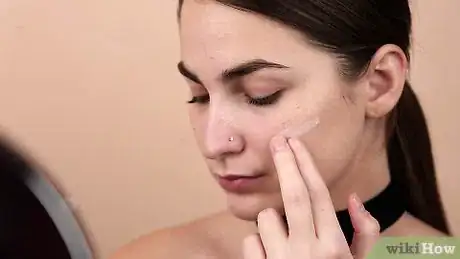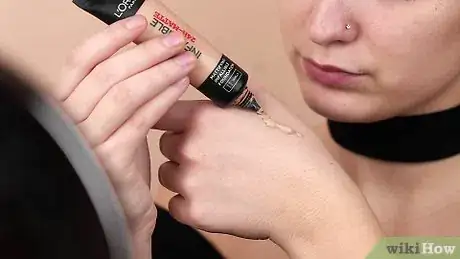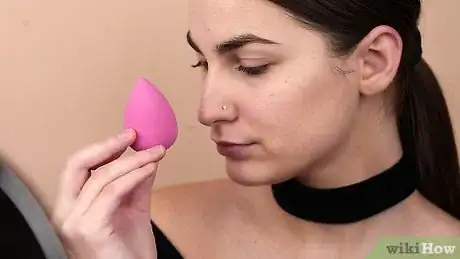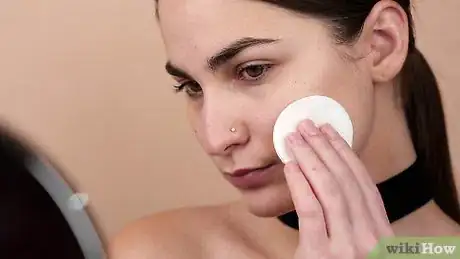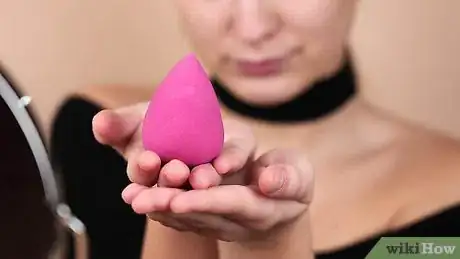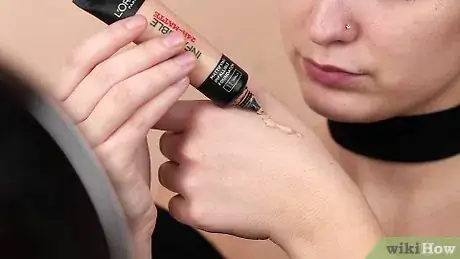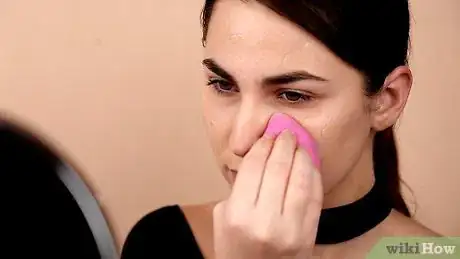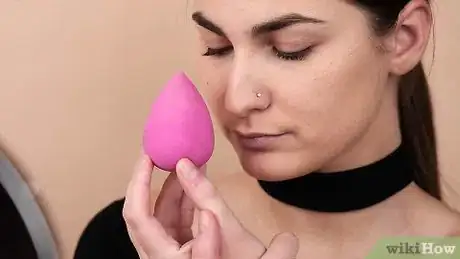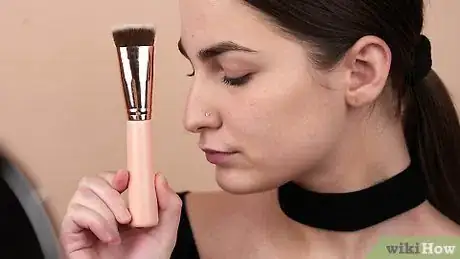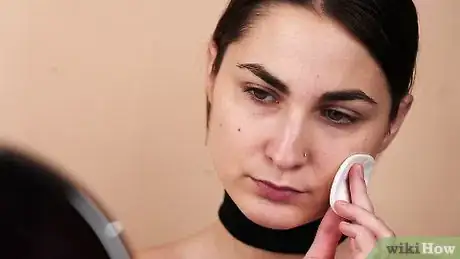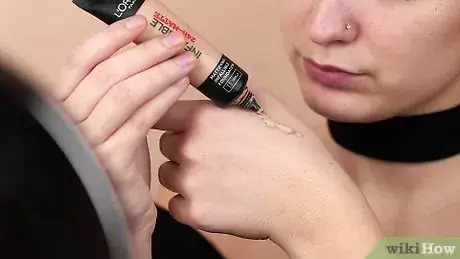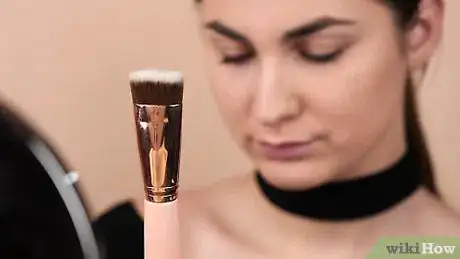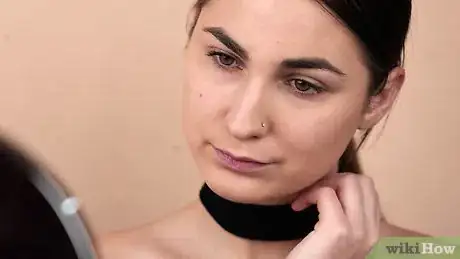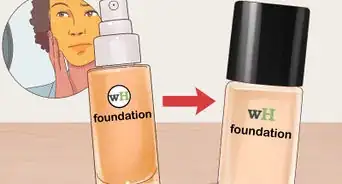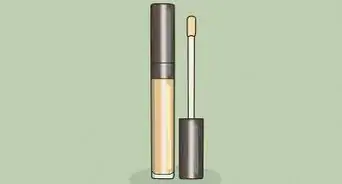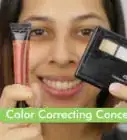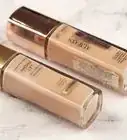This article was co-authored by Shara Strand. Shara Strand is a Makeup Artist and the Founder of Shara Makeup Studio, a makeup and image consulting studio based in New York City. She has over 15 years of image and makeup consulting experience including working as a regional artist for Bare Escentuals and Estee Lauder, Saks 5th Avenue, Bloomingdales, and Bergdorf Goodman. Her work has been featured in WNBC, Fox 5, Direct TV ABC morning news, and Hamptons Magazine. She is the creator of Shara Cosmetics and is a two time Billboard charted singer. She holds a BFA from New York University.
There are 11 references cited in this article, which can be found at the bottom of the page.
This article has been viewed 324,177 times.
Foundation is a type of skin-colored makeup that, when applied, makes your face appear clean and uniform. Liquid foundation is one of the most popular forms of foundation because it’s easy to use and offers great coverage.
Steps
Applying Liquid Foundation with Your Fingers
-
1Cleanse and moisturize your face. Makeup should always be applied to a clean canvas. Wash your face using your normal cleanser and pat dry. If you have dry skin, apply a moisturizer and wait a few minutes before applying foundation to give the moisturizer a chance to work.
- If you are in a hurry or have applied too much moisturizer, blot your face with a tissue to remove excess moisturizer before applying foundation.
-
2Pour a dime-sized amount of foundation onto your palette of choice. You can either use the back of your hand, a small dish, or even a folded up napkin. Don't pour out too much. You can always add more later.Advertisement
-
3Dip your fingertips into the foundation, and begin to dab it onto your face. Start with two dabs on your forehead, two on each cheek, one on your nose, and one on your chin. A little goes a long way with liquid foundation, and you can always add more to areas that need additional coverage.[1]
-
4Use your fingertips to blend the foundation into your skin. Use either a patting/tapping motion with just the pads of your fingers, or make small, light circles with your fingertips. Begin with the areas that tend to have the most uneven skin tone (nose, cheeks, and forehead for most people) and work out from there. [2]
- Make sure your circular motions are in an upward direction rather than a downward one. Pulling the skin downwards can cause your skin to sag over time.
- Think about blending the foundation lightly, not rubbing it in, and definitely not "slathering" it on.
- If you need more coverage, add more foundation to your face a dab at a time.
- When using your fingertips to apply foundation, the heat from your fingers will melt it before application. This is great if you are looking for less coverage. If you are going for a full-coverage look, use a generous amount of powder to set it afterwards.
-
5Blend the edges. Blend your foundation carefully into your jawline, hairline, and around your ears to avoid leaving distinct lines.
- If you have a sponge, use it to blend the foundation at your jawline using short downward strokes.
- If you notice a distinct color change at the jawline, you may need a different shade of foundation. It is normal for your face to be a little lighter than the rest of your body. If you find that your foundation is a little too light, you can blend it down to your neck. You can also try using a darker powder on top.
-
6Set your foundation. Wait 2-3 minutes for foundation to dry. If it is still noticeably moist, blot your face gently with a tissue. Apply other makeup, and then set your foundation with a translucent finishing powder. Apply the powder gently with a puff, and your makeup will last all day!
Applying Liquid Foundation with a Sponge
-
1Choose the correct sponge. The most popular sponges for applying liquid foundation are egg-shaped blending sponges made of antimicrobial foam. Both name brand and generic varieties are available at your local drugstore or cosmetics retailer.[3]
-
2Cleanse and moisturize your face. Use your regular products, and allow a few minutes for your moisturizer to fully absorb.
- For a really flawless finish, you may also apply a makeup primer at this time.
-
3Dampen the sponge. Immerse the sponge completely in water, and squeeze it several times to make sure it gets thoroughly saturated. Then wring the sponge out so that it is damp, but not sopping wet. You can wrap the sponge in a towel or washcloth and squeeze to quickly remove excess water.
-
4Pour a dime-sized amount of foundation onto your palette of choice. You can either use the back of your hand, a small dish, or a folded up napkin. Don't pour out too much. You can always add more later.
-
5Dip the base of your sponge lightly into the foundation. Sweep it back and forth a few time, until the surface of the sponge is covered in a light, uniform layer of foundation.[4]
-
6Dab or press the foundation into your skin. Instead of rubbing the foundation on, use quick dabbing motions to spread it around your face. Begin around the nose and cheeks, and continue applying with small, quick motions until you have an even coverage all over your face. Use the rounded, larger surface of the sponge or beauty blender for the larger areas on your face, such as your forehead, cheeks and jawline.
- Pressing the foundation in will create a flawless finish and fuller coverage by evening out skin texture.
- By rubbing or using strokes to apply your foundation, you risk applying an uneven amount to different areas of your face. This can also create lines where little hairs are present on the face.
-
7Use the point of the sponge for smaller areas. The pointed tip of the sponge is made for smaller areas, like the creases of the nose or around the eyes. Use a stippling or bouncing motion (short, quick dabs) to apply and blend with this part of the sponge.
-
8Blend the edges. Again, use a stippling motion to blend along the hairline, jawline and ears. Press the foundation into your skin by using dabbing motions. Do not sweep or rub the foundation in.
-
9Set your foundation. Wait 2-3 minutes for your foundation to dry. Blot with a tissue, if needed, and apply other makeup. Then apply a translucent finishing powder gently with a puff, or fluffy brush, and get ready for the compliments to come pouring in!
-
10Clean your sponge. When finished, rinse your sponge thoroughly with water, squeeze it out, and allow it to air dry. You should also clean your sponge with soap or a mild shampoo on a regular basis. Apply a small amount of soap, shampoo or brush cleaner, and squeeze your sponge several times until it is nice and sudsy. Then rinse thoroughly until no more bubbles appear, and allow to air dry.
- If your sponge has an odd smell or if it is not blending as well as it used to, you need to clean your sponge.
- If you do not clean your sponge regularly, it can grow bacteria and cause pimples or other skin irritations.
Applying Liquid Foundation with a Foundation Brush
-
1Choose the correct brush. While many kinds of brushes can be used to apply foundation, the best choice is a dense, flat-top brush specially designed for applying foundation.[5]
-
2Prepare your skin. Cleanse and moisturize your face using your regular products. Allow a few minutes for your moisturizer to fully absorb, and carefully blot any excess moisturizer with a tissue.
- For a perfect finish, you may also apply a makeup primer at this time.
-
3Pour a dime-sized amount of foundation onto your palette. You can either use the back of your hand, a small dish, or a folded up napkin. Spread the foundation out with your finger so that you have a thick even layer to dip your brush in.
-
4Dip the tip of the brush into the foundation. You only want to use the ends of the bristles. Don't dunk the brush or grind it into the foundation.
-
5Apply foundation to your face. Begin using a stippling, circular motion, starting at the nose, then move to the cheeks, chin, and forehead working in small circles. Work out from these central areas to the edges of your face, using short, quick strokes in the same direction.
- Remember to use a light touch, you want to sweep the foundation into your skin with the brush, not paint it on.
-
6Blend the edges. Continue to use a stippling motion to blend along the hairline, jawline and ears.
-
7Set your foundation. Wait 2-3 minutes for your foundation to dry. Blot with a tissue, if needed, and apply other makeup. Then apply a translucent finishing powder gently with a puff, or fluffy brush, and get ready for the compliments to come pouring in!
-
8Clean your brush. Blot your brush on a tissue to remove any remaining foundation. Clean your brush once a week using a mild shampoo or specialized brush cleaner.[6]
-
9Finished.
- Keep in mind that a liquid foundation for dry skin should contain hyaluronic acid. It adds the most hydration through collagen and elastin production.[7]
- The skin becomes dry because of a lack of oil. So you should ensure that you put some oil back into the skin.[8]
- There is no need to be concerned if the ingredients are not 100% natural.
Expert Q&A
-
QuestionHow to cover spots properly with foundation?
 Camille SangheraCamille Sanghera is the Owner of Lash Envy Cosmetics and Esvee Beauty in the Vancouver, British Columbia area. Camille is trained and certified in microblading, scalp micropigmentation, eyelash extensions, hair and makeup, and lash lifts. She is listed on Microblading Map Canada and has also been featured on TuneIn Radio and in Bridal Fashion Week Magazine.
Camille SangheraCamille Sanghera is the Owner of Lash Envy Cosmetics and Esvee Beauty in the Vancouver, British Columbia area. Camille is trained and certified in microblading, scalp micropigmentation, eyelash extensions, hair and makeup, and lash lifts. She is listed on Microblading Map Canada and has also been featured on TuneIn Radio and in Bridal Fashion Week Magazine.
Beauty Stylist Place a concealer or a liquid foundation made for full coverage on your spots. Wait a couple of minutes and then gently blend it into your skin. Once you have done this with all of your spots, apply another layer of foundation to your whole face. This should help cover spots. If your spots are still showing through, try an appropriate colour corrector underneath your foundation.
Place a concealer or a liquid foundation made for full coverage on your spots. Wait a couple of minutes and then gently blend it into your skin. Once you have done this with all of your spots, apply another layer of foundation to your whole face. This should help cover spots. If your spots are still showing through, try an appropriate colour corrector underneath your foundation. -
QuestionIs it proper to apply powder after the foundation in order to blend it?
 Camille SangheraCamille Sanghera is the Owner of Lash Envy Cosmetics and Esvee Beauty in the Vancouver, British Columbia area. Camille is trained and certified in microblading, scalp micropigmentation, eyelash extensions, hair and makeup, and lash lifts. She is listed on Microblading Map Canada and has also been featured on TuneIn Radio and in Bridal Fashion Week Magazine.
Camille SangheraCamille Sanghera is the Owner of Lash Envy Cosmetics and Esvee Beauty in the Vancouver, British Columbia area. Camille is trained and certified in microblading, scalp micropigmentation, eyelash extensions, hair and makeup, and lash lifts. She is listed on Microblading Map Canada and has also been featured on TuneIn Radio and in Bridal Fashion Week Magazine.
Beauty Stylist Applying powder after your foundation is ideal for keeping your foundation in place and for giving you a flawless finish. If you apply liquids or creams on top of a powder, you risk creating a chalky texture rather than a smooth texture.
Applying powder after your foundation is ideal for keeping your foundation in place and for giving you a flawless finish. If you apply liquids or creams on top of a powder, you risk creating a chalky texture rather than a smooth texture. -
QuestionWhere should I not apply foundation on my face?
 Community AnswerDon't apply it over your eyelids, lips or ears. It's a good idea to put some on your neck to help blend in the color.
Community AnswerDon't apply it over your eyelids, lips or ears. It's a good idea to put some on your neck to help blend in the color.
References
- ↑ http://stylecaster.com/how-apply-liquid-foundation-flawlessly/
- ↑ https://www.youtube.com/watch?v=Q4qLLyqA7vs
- ↑ https://www.youtube.com/watch?v=fOS4HMvHzWI
- ↑ http://thebeautydepartment.com/2013/07/beauty-basics-foundation-blending/
- ↑ http://www.makeupandbeautyblog.com/makeup-tipshow-to/how-to-apply-liquid-foundation/
- ↑ http://thebeautydepartment.com/2012/09/how-to-properly-wash-your-brushes/
- ↑ https://www.dbcosmetics.com.au/blogs/beauty-hub/hyaluronic-acid-benefits
- ↑ https://www.bebeautiful.in/all-things-makeup/face/the-difference-between-oil-water-and-silicone-based-foundations
- ↑ http://thebeautydepartment.com/2013/04/quick-tip-when-to-apply-concealer/
About This Article
To apply liquid foundation with your fingers, start with a clean and moisturized face. Then, pour a dime-sized amount of foundation onto the back of your hand or a makeup palette. Put 2 dabs of foundation on your forehead, 2 on each cheek, 1 on your nose, and 1 on your chin. Then, blend the foundation into your skin by tapping the makeup with your fingertips and spreading it around your face, getting rid of any distinct lines. For tips from our reviewer on applying foundation with a sponge or brush, read on!
